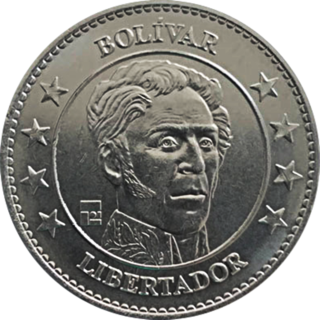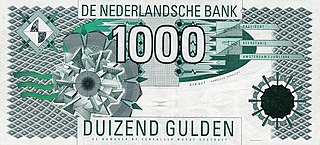Related Research Articles

The Polish złoty is the official currency and legal tender of Poland. It is subdivided into 100 grosz (gr). It is the most-traded currency in Central and Eastern Europe and ranks 21st most-traded in the foreign exchange market.
The renminbi, also known as the Chinese yuan, is the official currency of the People's Republic of China. The renminbi is issued by the People's Bank of China, the monetary authority of China. It is the world's fifth-most-traded currency as of April 2022.

The Deutsche Mark, abbreviated "DM" or "D-Mark" ( ), was the official currency of West Germany from 1948 until 1990 and later the unified Germany from 1990 until the adoption of the euro in 2002. In English, it was typically called the "Deutschmark". One Deutsche Mark was divided into 100 pfennigs.

The kroon was the official currency of Estonia for two periods in history: 1928–1940 and 1992–2011. Between 1 January and 14 January 2011, the kroon circulated together with the euro, after which the euro became the sole legal tender in Estonia. The kroon was subdivided into 100 cents.

The tenge is the currency of Kazakhstan. It is divided into 100 tiyn.
The dollar has been the currency of The Bahamas since 1966. It is normally abbreviated with the dollar sign $, or alternatively B$ to distinguish it from other dollar-denominated currencies. It is divided into 100 cents.

Legal tender is a form of money that courts of law are required to recognize as satisfactory payment for any monetary debt. Each jurisdiction determines what is legal tender, but essentially it is anything which, when offered ("tendered") in payment of a debt, extinguishes the debt. There is no obligation on the creditor to accept the tendered payment, but the act of tendering the payment in legal tender discharges the debt.

The pound sterling is the official currency of the United Kingdom, Jersey, Guernsey, the Isle of Man, British Antarctic Territory, South Georgia and the South Sandwich Islands, and Tristan da Cunha.

The Swiss franc, or simply the franc, is the currency and legal tender of Switzerland and Liechtenstein. It is also legal tender in the Italian exclave of Campione d'Italia which is surrounded by Swiss territory. The Swiss National Bank (SNB) issues banknotes and the federal mint Swissmint issues coins.

The bolívar is the official currency of Venezuela. Named after the hero of South American independence Simón Bolívar, it was introduced by President Guzman Blanco via the monetary reform of 1879, before which the venezolano was circulating. Due to its decades-long reliance on silver and gold standards, and then on a peg to the United States dollar, it was long considered among the most stable currencies.

The hryvnia has been the national currency of Ukraine since 2 September 1996. The hryvnia is divided into 100 kopiyok. It is named after a measure of weight used in Kievan Rus'.

The koruna, or crown, has been the currency of the Czech Republic since 1993. The koruna is one of the European Union's eight currencies, and the Czech Republic is legally bound to adopt the euro in the future.
The Luxembourg franc (F or ISO LUF, Luxembourgish: Frang), subdivided into 100 centimes, was the currency of Luxembourg between 1854 and 2002, except from 1941 to 1944. From 1944 to 2002, its value was equal to that of the Belgian franc. The franc remained in circulation until 2002, when it was replaced by the euro.

The guilder or florin was the currency of the Netherlands from 1434 until 2002, when it was replaced by the euro.
Since 1867 there have been four successive currencies in Romania known as the leu. This article details the banknotes denominated in the leu and its subdivision the ban since 1917, with images.

Banknotes of the euro, the common currency of the eurozone, have been in circulation since the first series was issued in 2002. They are issued by the national central banks of the Eurosystem or the European Central Bank. The euro was established in 1999, but "for the first three years it was an invisible currency, used for accounting purposes only, e.g. in electronic payments". In 2002, notes and coins began to circulate. The euro rapidly took over from the former national currencies and slowly expanded around the European Union.

The ten euro note (€10) is the second-lowest value euro banknote and has been used since the introduction of the euro in 2002. The note is used in the 25 countries that have it as their sole currency, which countries have a total population of about 350 million currently. In July 2024, there were approximately 3 055 000 000 ten euro banknotes in circulation around the eurozone. It is the fourth most widely circulated denomination, accounting for 10.2% of the total banknotes. Estimates suggest that the average life of a ten euro banknote is about 1.5 years before it is replaced due to wear.

The one hundred euro note (€100) is one of the higher value euro banknotes and has been used since the introduction of the euro in 2002. The note is used in the 25 countries that have adopted the euro as their sole currency, representing some 350 million people. In July 2024, there was an estimated 3,987,000,000 hundred euro banknotes in circulation in the eurozone. The note is the third most widely-circulated denomination, accounting for 13.3% of the total banknotes.

The two hundred euro note (€200) is the second highest value euro banknote and has been used since the introduction of the euro in 2002. The note is used in the 25 countries that have it as their sole currency, which countries have a total population of about 350 million currently. In July 2023, there were approximately 849 000 000 two hundred euro banknotes in circulation around the eurozone. It is the second least widely circulated denomination, accounting for 2.9% of the total banknotes.

The five-hundred-euro note (€500) is the highest-value euro banknote; it was produced between the introduction of the euro in 2002 until 2019. Since 27 April 2019, the banknote has no longer been issued by central banks in the euro area, but it continues to be legal tender and can be used as a means of payment.
References
- ↑ "Exchangeable notes - De Nederlandsche Bank". De Nederlandsche Bank. 5 September 2021. Archived from the original on 5 September 2021. Retrieved 5 September 2021.
- ↑ "Exchangeable notes - De Nederlandsche Bank". Archived from the original on 2019-10-05. Retrieved 2019-10-05.